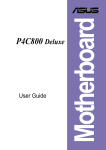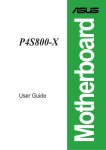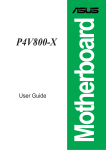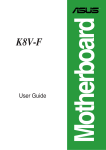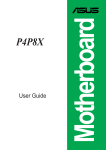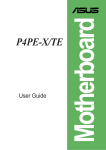Download Asus P4C800 Deluxe User guide
Transcript
User Guide Motherboard P4C800-E Deluxe Contents Features Notices ........................................................................................... vi Safety information ......................................................................... vii About this guide ............................................................................ viii ASUS contact information ............................................................... x P4C800-E Deluxe specifications summary .................................... xi Chapter 1: Product introduction 1.1 1.2 1.3 1.4 Welcome! ........................................................................... 1-1 Package contents ............................................................... 1-1 Special features .................................................................. 1-2 1.3.1 Product highlights .................................................. 1-2 1.3.2 Value-added solutions ............................................ 1-5 Motherboard overview ........................................................ 1-6 1.4.1 Major components ................................................. 1-6 1.4.2 Core specifications ................................................ 1-8 Chapter 2: Hardware information 2.1 2.2 2.3 2.4 2.5 2.6 Motherboard installation ..................................................... 2-1 2.1.1 Placement direction ............................................... 2-1 2.1.2 Screw holes ........................................................... 2-1 Motherboard layout ............................................................ 2-2 Before you proceed ............................................................ 2-3 Central Processing Unit (CPU) ........................................... 2-4 2.4.1 Overview ................................................................ 2-4 2.4.2 Installing the CPU .................................................. 2-5 2.4.3 Installing the heatsink and fan ............................... 2-7 2.4.4 Connecting the CPU fan cable .............................. 2-9 System memory ............................................................... 2-10 2.5.1 Overview .............................................................. 2-10 2.5.2 Memory configurations ........................................ 2-10 2.5.3 Installing a DIMM ................................................. 2-13 2.5.4 Removing a DIMM ............................................... 2-13 Expansion slots ................................................................ 2-14 2.6.1 Installing an expansion card ................................ 2-14 2.6.2 Configuring an expansion card ............................ 2-14 2.6.3 PCI slots .............................................................. 2-16 2.6.4 AGP Pro slot ........................................................ 2-17 2.6.5 Wi-Fi slot .............................................................. 2-18 iii P4C800-E Deluxe specifications summary CPU Socket 478 for Intel® Pentium® 4/Celeron with speeds up to 3.2+ GHz On-die 512KB/256KB L2 cache with full speed Supports Intel® Hyper-Threading Technology New power design supports next generation Intel Prescott CPU Chipset Intel 875P MCH (features the Intel Performance Acceleration Technology) Intel ICH5R Front Side Bus (FSB) 800/533/400 MHz Memory Dual-channel memory architecture 4 x 184-pin DDR DIMM sockets for up to 4GB memory Supports PC3200/2700/2100 unbuffered ECC or non-ECC DDR DIMMs Expansion slots 1 x AGP Pro/8X 5 x PCI 1 x Wi-Fi Storage Supported by South Bridge (ICH5R) - 2 x UltraDMA100 connectors - 2 x Serial ATA connectors (supports RAID0 configuration under Windows XP) Supported by Promise® PDC20378 controller (optional) - 1 x UltraDMA 133 connector - 2 x Serial ATA connectors - RAID0, RAID1, RAID0+1, Multi-RAID configurations IEEE 1394 VIA 6307 IEEE 1394 controller - supports 2 x IEEE 1394 connectors LAN Intel 82547EI Gigabit LAN controller AI Audio ADI AD1985 6-channel audio CODEC AI BIOS AI BIOS solutions: ASUS CrashFree BIOS 2 ASUS Q-Fan Technology ASUS POST Reporter™ AI Overclocking Intelligent CPU frequency tuner ASUS JumperFree Adjustable CPU VCORE, memory, and AGP voltages SFS (Stepless Frequency Selection) from 100MHz to 400MHz at 1MHz increments C. P. R. (CPU Parameter Recall) (continued on the next page) xi P4C800-E Deluxe specifications summary Special features ASUS MyLogo2 ASUS EZ Flash ASUS Instant Music Power Loss Restart Multi-language BIOS Rear panel I/O 1 x Parallel port 1 x Serial port 1 x PS/2 keyboard port 1 x PS/2 mouse port 1 x S/PDIF Out 1 x IEEE 1394 port (on 1394 models only) 4 x USB 2.0 ports 1 x RJ-45 port Line In/Line Out/Microphone ports Internal I/O 2 x USB 2.0 connectors for 4 additional USB ports CPU/Power/Chassis fan connectors 20-pin/4-pin ATX 12V power connectors IDE LED/Power LED connectors Chassis intrusion connector 1 x IEEE 1394 connector (on 1394 models only) GAME/MIDI connector S/PDIF Out connector CD/AUX/Modem audio connectors Front panel audio connector Serial port 2 (COM2) connector BIOS features 4Mb Flash ROM, AMI BIOS, PnP, DMI2.0, WfM2.0, SM BIOS2.3, Multi-language BIOS, ASUS EZ Flash, CrashFree BIOS 2, ASUS C.P.R., ASUS MyLogo2, ASUS Instant Music Industry standard PCI 2.2, PCI 2.3, USB 2.0 Manageability WfM 2.0. DMI 2.0, WOL/WOR by PME, chassis intrusion Power requirement ATX power supply (with 4-pin 12V plug) Form Factor ATX form factor: 12 in x 9.6 in (30.5 cm x 24.5 cm) Support CD contents Device drivers ASUS PC Probe ASUS LiveUpdate Trend Micro™ PC-cillin 2002 anti-virus software Specifications are subject to change without notice. xii Chapter 1 This chapter describes the features of the P4C800-E Deluxe motherboard. It includes brief explanations of the special attributes of the motherboard and the new technology it supports. Product introduction Chapter summary 1.1 Welcome! ........................................................ 1-1 1.2 Package contents .......................................... 1-1 1.3 Special features ............................................. 1-2 1.4 Motherboard overview ................................... 1-6 ASUS P4C800-E Deluxe motherboard 1.1 Welcome! Thank you for buying the ASUS® P4C800-E Deluxe motherboard! The ASUS P4C800-E Deluxe motherboard delivers a host of new features and latest technologies making it another standout in the long line of ASUS quality motherboards! The motherboard incorporates the Intel® Pentium® 4 Processor in 478-pin package coupled with the Intel® 875P chipset to set the latest trend for a powerful desktop platform solution. Supporting 800 MHz FSB, up to 4GB of system memory with PC3200/ 2700/2100 DDR SDRAM, high-resolution graphics via an AGP Pro/8X slot, Serial ATA support, IEEE 1394, USB 2.0, and 6-channel audio features, the P4C800-E Deluxe is your perfect vehicle to get ahead in the world of power computing! Before you start installing the motherboard, and hardware devices on it, check the items in your package with the list below. 1.2 Package contents Check your P4C800-E Deluxe package for the following items. ASUS P4C800-E Deluxe motherboard ASUS support CD InterVideo WinDVD Suite (retail boxes only) 4 x SATA cable SATA power cable (retail boxes only) 2 x 80-conductor ribbon cables for UltraDMA133/100/66 IDE drives 40-conductor IDE cable Ribbon cable for a 3.5-inch floppy drive IEEE 1394 module 4-port USB2.0/GAME module I/O shield Bag of extra jumper caps User Guide Quick Reference Card (last page of the User Guide) Quick Setup Guide (retail boxes only) Jumpers and Connectors Sticker (retail boxes only) Instant Music keyboard label (retail boxes only) If any of the above items is damaged or missing, contact your retailer. ASUS P4C800-E Deluxe motherboard user guide 1-1 1.4 Motherboard overview Before you install the motherboard, familiarize yourself with its physical configuration and available features to facilitate the motherboard installation and future upgrades. A sufficient knowledge of the motherboard specifications will also help you avoid mistakes that may damage the board and its components. 1.4.1 Major components The following are the major components of the P4C800-E Deluxe motherboard as pointed out in the picture on page 1-7. 1. CPU socket 18. Wi-Fi slot 2. North Bridge controller 19. Super I/O controller 3. ATX12V power connector 20. PCI slots 4. DDR DIMM sockets 21. Audio CODEC 5. Floppy disk connector 22. Gigabit LAN controller 6. IDE connectors 23. PS/2 mouse port 7. ATX power connector 24. Parallel port 8. AGP Pro/8X slot 25. IEEE 1394 port (optional) 9. Standby power LED 26. RJ-45 port 10. Flash ROM 27. Line In jack 11. 28. Line Out jack Speech controller 12. RAID Ultra ATA133 connector 29. Microphone jack 13. SATA connectors 30. USB 2.0 ports 3 and 4 14. SATA RAID connectors 31. USB 2.0 ports 1 and 2 15. RAID/SATA/IDE controller 32. Serial port 16. South Bridge controller 33. S/PDIF out port 17. IEEE 1394 controller (optional) 34. PS/2 keyboard port See page 1-8 for the specifications of each component. Refer to Chapter 2 for detailed information on the components. 1-6 Chapter 1: Product introduction 1 2 3 4 5 6 7 8 22 9 10 21 20 11 19 23 18 17 24 25 1615 14 13 12 26 27 28 29 34 33 32 31 ASUS P4C800-E Deluxe motherboard user guide 30 1-7 1.4.2 Core specifications 1-8 1 CPU socket. A 478-pin surface mount, Zero Insertion Force (ZIF) socket for the Intel® Pentium® 4 Processor, with 800/533/400 MHz system bus that allows 6.4GB/s, 4.3GB/s, and 3.2GB/s data transfer rates, respectively. The socket will support the Intel Prescott CPU when available. 2 North bridge controller. The Intel® 875P Memory Controller Hub (MCH) provides the CPU interface, DDR interface, AGP interface, and Hub Interface. The MCH manages the flow of information between these interfaces. Designed for use with the Intel® Pentium 4/Celeron processor, the MCH provides the processor interface with 800/533/400 MHz frequency, system memory interface with up to 6.4GB/s bandwidth in dual-channel mode, and 0.8V/1.5V AGP Interface Specification 3.0 that supports 8X/4X Fast Write protocol. The MCH interconnects to the south bridge ICH5R via the Intel® proprietary Hub Interface. 3 ATX 12V connector. This power connector connects the 4-pin 12V plug from the ATX 12V power supply. 4 DDR DIMM sockets. These four 184-pin DIMM sockets support up to 4GB system memory using unbuffered ECC or non-ECC PC3200/ PC2700/PC2100 DDR DIMMs. 5 Floppy disk connector. This connector accommodates the provided ribbon cable for the floppy disk drive. One side of the connector is slotted to prevent incorrect insertion of the floppy disk cable. 6 IDE connectors. These dual-channel bus master IDE connectors support Ultra DMA/100/66, PIO Modes 3 & 4 IDE devices. Both the primary (blue) and secondary (black) connectors are slotted to prevent incorrect insertion of the IDE ribbon cable. 7 ATX power connector. This 20-pin connector connects to an ATX 12V power supply. The power supply must have at least 1A on the +5V standby lead (+5VSB). 8 AGP Pro/8X slot. This Accelerated Graphics Port (AGP) Pro slot supports 0.8V/1.5V AGP 8X mode graphics cards for 3D graphical applications and delivers up to 2.1GB/s bandwidth. 9 Standby power LED. This LED lights up if there is a standby power on the motherboard. This LED acts as a reminder to turn off the system power before plugging or unplugging devices. 10 Flash ROM. This 4Mb firmware hub (FWH) contains the programmable BIOS program. Chapter 1: Product introduction 11 Speech controller. This Winbond speech controller supports the ASUS POST Reporter™ for configurable vocal POST alerts. 12 RAID Ultra ATA133 connector. This connector supports two Ultra ATA133 HDDs. On RAID models, the HDDs on this connector may be configured as RAID0, RAID1, or RAID0+1 together with the Serial ATA HDDs on the SATA RAID connectors. 13 SATA connectors. These connectors support Serial ATA HDDs and allows for up to 150MB/s data transfer rate using the thin 4-conductor SATA cables. The HDDs may be configured as RAID 0 level storage under Windows XP operating system. 14 SATA RAID connectors. These connectors support Serial ATA HDDs and may be configured as RAID0, RAID1, RAID0+1. Together with the UltraDMA133 devices, if present, the SATA RAID devices may be set up as a multi-RAID configuration. (on RAID models only) 15 RAID/SATA/IDE controller. The Promise® PDC20378 RAID controller provides high-performance RAID0/RAID1/RAID0+1 functionality and complies with the Serial ATA and UltraDMA 133 specifications. (on RAID models only) 16 South bridge controller. The fifth-generation Intel I/O Controller Hub (ICH5R) is a subsystem that integrates various I/O functions including 2-channel ATA/100 bus master IDE controller, SATA RAID controller, up to eight USB 2.0/1.1 ports, I/O APIC, LPC interface, AC’97 2.3 interface, and PCI 2.2/2.3 interface. The ICH5 also contains the necessary arbitration and buffering for efficient utilization of these interfaces. 17 IEEE 1394 controller. The VIA VT6307 controller chipset supports two low power IEEE 1394 connectors to allow 100Mbps, 200Mbps, and 400Mbps data transfers between the 1394 devices. (on 1394 models only) 18 Wi-Fi slot. The Wi-Fi (Wireless Fidelity) slot connects a Wi-Fi equipment for wireless networking that allows 11Mbps transmission (with a fallback to 5.5, 2, and 1 Mbps) in the 2.4 GHz band. Wi-Fi networks use radio technologies known as IEEE 802.11b (or later) to provide a fast reliable wireless connectivity. 19 Super I/O controller. This Winbond Low Pin Count (LPC) interface provides the commonly used Super I/O functionality. The chipset supports a high-performance floppy disk controller for a 360K/720K/1.44M/2.88M floppy disk drive, a multi-mode parallel port, two standard compatible UARTs, and a Flash ROM interface. This controller also integrates the ASIC for PC health monitoring. ASUS P4C800-E Deluxe motherboard user guide 1-9 20 PCI slots. These five 32-bit PCI 2.2 expansion slots support bus master PCI cards like SCSI or LAN cards with 133MB/s maximum throughput. 21 Audio CODEC. The AD1985 AC ‘97 2.3 stereo audio CODEC provides a 6-channel audio capability. The CODEC supports surround sound output, variable sample rate conversion, analog enumeration capability, and other major audio technologies for a complete integrated audio solution. 22 Gigabit LAN controller. The Intel® 82547EI Gigabit Ethernet controller allows full-duplex Gigabit performance on LAN on Motherboard (LOM) applications through the Communication Streaming Architecture (CSA). The controller combines Intel’s fifth-generation Gigabit MAC design integrated with physical layer circuitry (PHY) to support 1000BASE-T, 100BASE-TX, and 10BASE-T applications. 23 PS/2 mouse port. This green 6-pin connector is for a PS/2 mouse. 24 Parallel port. This 25-pin port connects a parallel printer, a scanner, or other devices. 25 IEEE 1394 port. This port connects IEEE 1394-compliant devices like camcorders, VCRs, printers, or digital cameras. (on 1394 models only) 26 RJ-45 port. This port allows connection to a Local Area Network (LAN) through a network hub. 27 Line In jack. This Line In (light blue) jack connects a tape player or other audio sources. In 6-channel mode, the function of this jack becomes Rear Speaker Out. 28 Line Out jack. This Line Out (lime) jack connects a headphone or a speaker. In 6-channel mode, the function of this jack becomes Front Speaker Out. 29 Microphone jack. This Mic (pink) jack connects a microphone. In 6-channel mode, the function of this jack becomes Bass/Center. 30 USB 2.0 ports 3 and 4. These 4-pin Universal Serial Bus (USB) ports are available for connecting USB 2.0 devices. 31 USB 2.0 ports 1 and 2. These 4-pin Universal Serial Bus (USB) ports are available for connecting USB 2.0 devices. 32 Serial port. This 9-pin COM1 port is for pointing devices or other serial devices. 33 S/PDIF out port. This connector supports S/PDIF devices that provides 5.1-channel surround sound and 3D audio. 34 PS/2 keyboard port. This purple connector is for a PS/2 keyboard. 1-10 Chapter 1: Product introduction Chapter 2 This chapter describes the hardware setup procedures that you have to perform when installing system components. It includes details on the switches, jumpers, and connectors on the motherboard. Hardware information Chapter summary 2.1 Motherboard installation ............................... 2-1 2.2 Motherboard layouts ..................................... 2-2 2.3 Before you proceed ....................................... 2-3 2.4 Central Processing Unit (CPU) ..................... 2-4 2.5 System memory ........................................... 2-10 2.6 Expansion slots ........................................... 2-14 2.7 Jumpers ........................................................ 2-19 2.8 Connectors ................................................... 2-21 ASUS P4C800-E Deluxe motherboard 2.1 Motherboard installation Before you install the motherboard, study the configuration of your chassis to ensure that the motherboard fits into it. The motherboard uses the ATX form factor that measures 12 inches x 9.6 inches (30.5 x 24.5 cm). Make sure to unplug the power cord before installing or removing the motherboard. Failure to do so may cause you physical injury and damage motherboard components. 2.1.1 Placement direction When installing the motherboard, make sure that you place it into the chassis in the correct orientation. The edge with external ports goes to the rear part of the chassis as indicated in the image below. 2.1.2 Screw holes Place nine (9) screws into the holes indicated by circles to secure the motherboard to the chassis. Do not overtighten the screws! Doing so may damage the motherboard. Place this side towards the rear of the chassis ASUS P4C800-E Deluxe motherboard user guide 2-1 2.2 Motherboard layout 24.5cm (9.6in) KBPWR SMB USBPW34 USB2.0 Top: T: USB4 RJ-45 B: USB3 Intel 875P Memory Controller Hub (MCH) Top:Line In Center:Line Out Below:Mic In SEC_IDE ® 30.5cm (12.0in) Top: USB2 USB1 1394 ATX Power Connector Bottom: DDR DIMM_B2 (64/72 bit,184-pin module) USBPW12 DDR DIMM_B1 (64/72 bit,184-pin module) CPU_FAN DDR DIMM_A2 (64/72 bit,184-pin module) PWR_FAN DDR DIMM_A1 (64/72 bit,184-pin module) COM1 Socket 478 PARALLEL PORT SPDIF_O FLOPPY CR2032 3V Lithium Cell CMOS Power ATX12V PRI_IDE PS/2KBMS T: Mouse B: Keyboard 4Mbit Firmware Hub PCI1 USB56 SMB20 USBPW78 USBPW56 PCI2 Intel ICH5R P4C800-E USB78 PCI3 AUX FP_AUDIO SATA2 SATA1 VIA VT6307 Chipset MODEM Super I/O Speech Controller CD PCI4 GAME CHA_FAN PCI5 SATA_RAID2 SATA_RAID1 CHASSIS PRI_RAID SPDIF_OUT PROMISE PDC20378 RAID Controller AD1985 CODEC CLRTC SB_PWR Accelerated Graphics Port (AGP_PRO) Intel 82547EI Gigabit LAN PANEL WIFI COM2 IE1394_2 TRPWR The RAID and 1394 features are optional. These components are grayed out in the above motherboard layout. 2-2 Chapter 2: Hardware information 2.3 Before you proceed Take note of the following precautions before you install motherboard components or change any motherboard settings. 1. Unplug the power cord from the wall socket before touching any component. 2. Use a grounded wrist strap or touch a safely grounded object or to a metal object, such as the power supply case, before handling components to avoid damaging them due to static electricity. 3. Hold components by the edges to avoid touching the ICs on them. 4. Whenever you uninstall any component, place it on a grounded antistatic pad or in the bag that came with the component. 5. Before you install or remove any component, ensure that the ATX power supply is switched off or the power cord is detached from the power supply. Failure to do so may cause severe damage to the motherboard, peripherals, and/or components. When lit, the green LED (SB_PWR) indicates that the system is ON, in sleep mode, or in soft-off mode, a reminder that you should shut down the system and unplug the power cable before removing or plugging in any motherboard component. ® SB_PWR P4C800-E P4C800-E Onboard LED ON Standby Power ASUS P4C800-E Deluxe motherboard user guide OFF Powered Off 2-3 2.4 Central Processing Unit (CPU) 2.4.1 Overview The motherboard comes with a surface mount 478-pin Zero Insertion Force (ZIF) socket. The socket is designed for the Intel® Pentium® 4 Processor in the 478-pin package with 512KB L2 cache. The Pentium 4 processor features the Intel® NetBurst™ micro-architecture, HyperThreading Technology, and 800/533/400MHz system bus. Together, these attributes improve system performance by allowing higher core frequencies, faster execution of integer instructions, and data transfer rates up to 6.4GB/s. The socket will also support the Intel Prescott CPU when available. Gold Mark Note in the illustration that the CPU has a gold triangular mark on one corner. This mark indicates the processor Pin 1 that should match a specific corner of the CPU socket. Incorrect installation of the CPU into the socket may bend the pins and severely damage the CPU! Notes on Intel® Hyper-Threading Technology 1. This motherboard supports Intel Pentium 4 CPUs with HyperThreading Technology. 2. Hyper-Threading Technology is supported under Windows XP and Linux 2.4.x (kernel) and later versions only. Under Linux, use the Hyper-Threading compliler to compile the code. If you are using any other operating systems, disable the Hyper-Threading Techonology item in BIOS to ensure system stability and performance. 3. It is recommended that you install WinXP Service Pack 1. 4. Make sure to enable the Hyper-Threading Technology item in BIOS before installing a supported operating system. 5. For more information on Hyper-Threading Technology, visit www.intel.com/info/hyperthreading. 2-4 Chapter 2: Hardware information To use the Hyper-Threading Technology on this motherboard: 1. Buy an Intel Pentium 4 CPU that supports Hyper-Threading Technology. Install the CPU. 2. Power up the system and enter BIOS Setup (see Chapter 4). Under the Advanced Menu, make sure that the item Hyper-Threading Technology is set to Enabled. The item appears only if you installed a CPU that supports Hyper-Threading Techonology. 3. Reboot the computer. 2.4.2 Installing the CPU Follow these steps to install a CPU. 1. Locate the 478-pin ZIF socket on the motherboard. 2. Unlock the socket by pressing the lever sideways, then lift it up to a 90°-100° angle. Socket Lever 90 - 100 Make sure that the socket lever is lifted up to 90°-100° angle, otherwise the CPU does not fit in completely. ASUS P4C800-E Deluxe motherboard user guide 2-5 3. Position the CPU above the socket such that its marked corner matches the base of the socket lever. 4. Carefully insert the CPU into the socket until it fits in place. Gold Mark The CPU fits only in one correct orientation. DO NOT force the CPU into the socket to prevent bending the pins and damaging the CPU! 5. When the CPU is in place, push down the socket lever to secure the CPU. The lever clicks on the side tab to indicate that it is locked. 2-6 Chapter 2: Hardware information 2.4.3 Installing the heatsink and fan The Intel® Pentium® 4 Processor requires a specially designed heatsink and fan assembly to ensure optimum thermal condition and performance. When you buy a boxed Intel Pentium 4 Processor, the package includes the heatsink, fan, and retention mechanism. In case you buy a CPU separately, make sure that you use only Intel certified heatsink and fan. Follow these steps to install the CPU heatsink and fan. 1. Place the heatsink on top of the installed CPU, making sure that the heatsink fits properly on the retention module base. The retention module base is already installed on the motherboard upon purchase. You do not have to remove the retention module base when installing the CPU or installing other motherboard components. CPU Heatsink Retention Module Base Your boxed Intel Pentium 4 Processor package should come with installation instructions for the CPU, heatsink, and the retention mechanism. If the instructions in this section do not match the CPU documentation, follow the latter. ASUS P4C800-E Deluxe motherboard user guide 2-7 2. Position the fan with the retention mechanism on top of the heatsink. Align and snap the four hooks of the retention mechanism to the holes on each corner of the module base. Make sure that the fan and retention mechanism assembly perfectly fits the heatsink and module base, otherwise you cannot snap the hooks into the holes. Retention Hole Retention Lock Retention Hook Snapped to the Retention Hole Keep the retention locks lifted upward while fitting the retention mechanism to the module base. 2-8 Chapter 2: Hardware information 3. Push down the locks on the retention mechanism to secure the heatsink and fan to the module base. When secure, the retention locks should point to opposite directions. 2.4.4 Connecting the CPU fan cable When the fan, heatsink, and the retention mechanism are in place, connect the CPU fan cable to the connector on the motherboard labeled CPU_FAN. CPU Fan Connector (CPU_FAN) Don’t forget to connect the CPU fan connector! Hardware monitoring errors may occur if you fail to plug this connector. ASUS P4C800-E Deluxe motherboard user guide 2-9 2.5 System memory 2.5.1 Overview The motherboard comes with four Double Data Rate (DDR) Dual Inline Memory Module (DIMM) sockets. These sockets support up to 4GB system memory using 184-pin unbuffered ECC or non-ECC PC3200/ PC2700/PC2100 DDR DIMMs, and allow up to 6.4GB/s data transfer rate. 104 Pins DIMM_B2 DIMM_B1 DIMM_A2 DIMM_A1 The following figure illustrates the location of the DDR DIMM sockets. 80 Pins ® P4C800-E P4C800-E 184-Pin DDR DIMM Sockets 2.5.2 Memory configurations You may install 64MB, 128MB, 256MB, 512MB, and 1GB DDR DIMMs into the DIMM sockets using the memory configurations in this section. Important notes 1. Installing DDR DIMMs other than the recommended configurations may cause memory sizing error or system boot failure. Use any of the recommended configurations in Table 1. 2. In dual-channel configurations, install only identical (the same type and size) DDR DIMM pairs for each channel. 3. Always install DIMMs with the same CAS latency. For optimum compatibility, it is recommended that you obtain memory modules from the same vendor. 4. Make sure that the memory frequency matches the CPU FSB (Front Side Bus). Refer to Table 2. 5. DIMMs installed into any three sockets will function in singlechannel mode. 6. When all four sockets are populated with 1GB DIMMs (total 4GB), the system may detect only 3+GB (a little less than 4GB) due to ICH5R resource allocation. 2-10 Chapter 2: Hardware information Table 1 Recommended memory configurations Mode DIMM_A1 (blue) Single-channel Dual-channel Sockets DIMM_A2 DIMM_B1 (black) (blue) DIMM_B2 (black) (1) Populated — — — (2) — Populated — — (3) — — Populated — (4) — — — Populated — Populated — (1) Populated (2) — Populated — Populated (3)* Populated Populated Populated Populated * For dual-channel configuration (3), you may: • install identical DIMMs in all four sockets or • install identical DIMM pair in DIMM_A1 and DIMM_B1 (blue sockets) and identical DIMM pair in DIMM_A2 and DIMM_B2 (black sockets) Table 2 Memory frequency/CPU FSB synchronization CPU FSB DDR DIMM Type Memory Frequency 800 MHz PC3200/PC2700*/PC2100 400/333*/266 MHz 533 MHz PC2700/PC2100 333/266 MHz 400 MHz PC2100 266 MHz *When using 800MHz CPU FSB, PC2700 DDR DIMMs may run only at 320MHz (not 333MHz) due to chipset limitation. ASUS P4C800-E Deluxe motherboard user guide 2-11 Table 3 Size DDR400 Qualified Vendor List (QVL) Vendor Model Brand Component Max. DIMMs 256MB Transcend TS32MLD64V4F3 Samsung K4H560838D-TCC4 2 512MB Transcend TS64MLD64V4F3 Samsung K4H560838D-TCC4 2 256MB Transcend TS32MLD64V4F3 Mosel V58C2256804SAT5 4 512MB Transcend TS64MLD64V4F3 Mosel V58C2256804SAT5 2 256MB Kingston KVR400X64C25/256 Winbond W942508BH-5 4 512MB Kingston KVR400X64C25/512 Winbond W942508BH-5 2 256MB Kingston KVR400X72C25/256 Winbond W942508BH-5(ECC) 2 512MB Kingston KVR400X72C25/512 Winbond W942508BH-5(ECC) 2 256MB Winbond W9425GCDB-5 Winbond W942508CH-5 4 512MB Winbond W9451GCDB-5 Winbond W942508CH-5 4 128MB Infineon HYS64D16301GU-5-B Infineon HYB25D256160BT-5B 4 256MB Infineon HYS64D32300GU-5-B Infineon HYB25D256800BT-5B 4 512MB Infineon HYS64D64320GU-5-B Infineon HYB25D256800BT-5B 2 256MB Samsung M381L3223ETM-CCC Samsung K4H560838E-TCCC(ECC) 4 512MB Samsung M381L6423ETM-CCC Samsung K4H560838E-TCCC(ECC) 4 128MB Micron MT8VDDT1664AG-403B2 Micron MT46V16M8-5ESB 1 256MB Micron MT16VDDT3264AG-403B2 Micron MT46V16M8-5ESB 1 256MB Micron MT16VDDT3264AG-403B5 Micron MT46V16M8-5TESB 2 256MB Hynix HYMD232646B8J-D43 AA Hynix HY5DU56822BT-D43 4 512MB Hynix HYMD264646B8J-D43 AA Hynix HY5DU56822BT-D43 4 256MB TwinMos M2G9I08AFATT9F081AA4T TwinMos TMD7608F8E50D 1 512MB TwinMos M2G9J16AGATT9F081AA4T TwinMos TMD7608F8E50D 1 256MB Apacer 77.10636.465 Samsung K4H560838D-TCC4 4 512MB Apacer 77.10736.464 Samsung K4H560838D-TCC4 2 256MB ADATA MDOAD5F3G315B1ECZ ADATA ADD8608A8A-5B 2 256MB ADATA MDOSS6F3G31JB1EAE Samsung K4H560838D-TCC4 2 256MB ADATA MDOWB5F3G316B1EAE Winbond W942508BH-5 4 512MB PSC AL6D8A53T1-5B PSC A2S56D30ATP 4 256MB CORSAIR CMX256A-3500C2 Winbond W942508BH-5 2 512MB CORSAIR CMX512-3500C2 Winbond W942508BH-5 2 512MB KINGMAX MPXC22D-38KT3R Kingmax KDL388P4EA-50 1 256MB Micron MT8VDDT3264AG-40BC4 Micron MT46V32M8TG-5BC 4 512MB Micron MT16VDDT6464AG-40BC4 Micron MT46V32M8TG-5BC 4 256MB ATP AG32L64T8SQC4S Samsung K4H560838D-TCC4 1 512MB ATP AG64L64T8SQC4S Samsung K4H560838D-TCC4 1 512MB TAKEMS MS64D64020U-5 TAKEMS MS25D25680S-5 2 256MB OCZ N/A OCZ X4W560840A-40 2 Obtain DDR DIMMs only from ASUS qualified vendors for better system performance. Visit the ASUS website (www.asus.com) for the latest QVL. 2-12 Chapter 2: Hardware information 2.5.3 Installing a DIMM Make sure to unplug the power supply before adding or removing DIMMs or other system components. Failure to do so may cause severe damage to both the motherboard and the components. Follow these steps to install a DIMM. DDR DIMM notch 1. Unlock a DIMM socket by pressing the retaining clips outward. 2. Align a DIMM on the socket such that the notch on the DIMM matches the break on the socket. Unlocked Retaining Clip A DDR DIMM is keyed with a notch so that it fits in only one direction. DO NOT force a DIMM into a socket to avoid damaging the DIMM. 3. Firmly insert the DIMM into the socket until the retaining clips snap back in place and the DIMM is properly seated. Locked Retaining Clip 2.5.4 Removing a DIMM Follow these steps to remove a DIMM. 1. Simultaneously press the retaining clips outward to unlock the DIMM. Support the DIMM lightly with your fingers when pressing the retaining clips. The DIMM might get damaged when it flips out with extra force. 2. Remove the DIMM from the socket. ASUS P4C800-E Deluxe motherboard user guide 2-13 2.6 Expansion slots In the future, you may need to install expansion cards. The motherboard has five PCI slots, one Accelerated Graphics Port (AGP) Pro slot, and a Wi-Fi slot. The following sub-sections describe the slots and the expansion cards that they support. Make sure to unplug the power cord before adding or removing expansion cards. Failure to do so may cause you physical injury and damage motherboard components. 2.6.1 Installing an expansion card Follow these steps to install an expansion card. 1. Before installing the expansion card, read the documentation that came with it and make the necessary hardware settings for the card. 2. Remove the system unit cover (if your motherboard is already installed in a chassis). 3. Remove the bracket opposite the slot that you intend to use. Keep the screw for later use. 4. Align the card connector with the slot and press firmly until the card is completely seated on the slot. 5. Secure the card to the chassis with the screw you removed earlier. 6. Replace the system cover. 2.6.2 Configuring an expansion card After installing the expansion card, configure the it by adjusting the software settings. 1. Turn on the system and change the necessary BIOS settings, if any. See Chapter 4 for information on BIOS setup. 2. Assign an IRQ to the card. Refer to the tables on the next page. 3. Install the software drivers for the expansion card. 2-14 Chapter 2: Hardware information Standard Interrupt Assignments IRQ 0 1 2 3* 4* 5* 6 7* 8 9* 10* 11* 12* 13 14* 15* * Priority 1 2 N/A 11 12 13 14 15 3 4 5 6 7 8 9 10 Standard Function System Timer Keyboard Controller Programmable Interrupt Communications Port (COM2) Communications Port (COM1) Sound Card (sometimes LPT2) Floppy Disk Controller Printer Port (LPT1) System CMOS/Real Time Clock ACPI Mode when used IRQ Holder for PCI Steering IRQ Holder for PCI Steering PS/2 Compatible Mouse Port Numeric Data Processor Primary IDE Channel Secondary IDE Channel These IRQs are usually available for ISA or PCI devices. IRQ assignments for this motherboard A B PCI slot 1 — — PCI slot 2 — — PCI slot 3 — — PCI slot 4 — — PCI slot 5 — — AGP Pro slot shared used Onboard USB controller HC0 shared — Onboard USB controller HC1 — — Onboard USB controller HC2 — — Onboard USB controller HC3 shared — Onboard USB 2.0 controller — — Onboard LAN (optional) — — Onboard SATA (optional) — — Onboard 1394 (optional) — — C — — — — — — — — used — — — — — D E F G H — — shared — — — — — shared — — — — — shared — shared — — — — — shared — — — — — — — — — — — — used — — — — — — — — — — — — — — — — — — shared — — — shared — — — — — shared — shared — — — When using PCI cards on shared slots, ensure that the drivers support “Share IRQ” or that the cards do not need IRQ assignments. Otherwise, conflicts will arise between the two PCI groups, making the system unstable and the card inoperable. ASUS P4C800-E Deluxe motherboard user guide 2-15 2.6.3 PCI slots There are five 32-bit PCI slots on this motherboard. The slots support PCI cards such as a LAN card, SCSI card, USB card, and other cards that comply with PCI specifications. 1. The PCI 5 slot and the Wi-Fi slot may not be used at the same time. 2. When installing long PCI cards, it is recommended that you install them in PCI slots 1, 2, or 5. Long PCI cards installed in PCI slots 3 and 4 may interfere with the SATA and GAME connectors. 2-16 Chapter 2: Hardware information 2.6.4 AGP Pro slot This motherboard has an Accelerated Graphics Port (AGP) Pro slot that supports AGP 8X (+0.8V) cards and AGP 4X (+1.5V) cards. When you buy an AGP card, make sure that you ask for one with +0.8V or +1.5V specification. Note the notches on the card golden fingers to ensure that they fit the AGP slot on your motherboard. Install only +0.8V or +1.5V AGP cards. This motherboard does not support 3.3V AGP cards. ® P4C800-E Keyed for 1.5v P4C800-E Accelerated Graphics Port (AGP) If installing the ATi 9500 or 9700 Pro Series VGA cards, use only the card version PN xxx-xxxxx-30 or later, for optimum performance and overclocking stability. ASUS P4C800-E Deluxe motherboard user guide 2-17 2.6.5 Wi-Fi slot The Wi-Fi (Wireless Fidelity) slot will support the ASUS Wi-Fi module when available. Visit the ASUS website (www.asus.com) for product updates. The Wi-Fi slot conforms to the Institute of Electrical and Electronics Engineers (IEEE) 802.11b standard for wireless devices operating in the 2.4 GHz frequency band. ® WIFI P4C800-E P4C800-E WIRELESS Connectors The PCI 5 slot and the Wi-Fi slot may not be used at the same time. IEEE 802.11b introduction The IEEE 802.11b standard includes provisions for three radio technologies: direct sequence spread spectrum, frequency hopping spread spectrum, and infrared. Devices that comply with the 802.11b standard operate at data rates of up to 11 Mbps for direct sequence spread spectrum. The IEEE 802.11b specification allocates the 2.4 GHz frequency band into 14 overlapping operating channels. Each Channel corresponds to a different set of frequencies. If operating multiple 802.11b wireless PCI cards in the same vicinity, the distance between the center frequencies must be at least 25 MHz to avoid interference. The channels available to an 802.11b wireless PCI card will vary from country to country. In the United States, the 802.11b standard allocates 11 operating channels for direct sequence devices. Channels 1, 6, and 11 are independent and do not overlap with each other. 2-18 Chapter 2: Hardware information 2.7 Jumpers 1. Keyboard power (3-pin KBPWR) This jumper allows you to enable or disable the keyboard wake-up feature. Set this jumper to pins 2-3 (+5VSB) if you wish to wake up the computer when you press a key on the keyboard (the default is the Space Bar). This feature requires an ATX power supply that can supply at least 1A on the +5VSB lead, and a corresponding setting in the BIOS (see section 4.5.1 Power Up Control). KBPWR 1 2 ® +5V (Default) 2 3 +5VSB P4C800-E P4C800-E Keyboard Power Setting 2. Clear RTC RAM (CLRTC) This jumper allows you to clear the Real Time Clock (RTC) RAM in CMOS. You can clear the CMOS memory of date, time, and system setup parameters by erasing the CMOS RTC RAM data. The RAM data in CMOS, that include system setup information such as system passwords, is powered by the onboard button cell battery. To erase the RTC RAM: 1. Turn OFF the computer and unplug the power cord. 2. Move the jumper cap from pins 1-2 (default) to pins 2-3. Keep the cap on pins 2-3 for about 5~10 seconds, then move the cap back to pins 1-2. 3. Plug the power cord and turn ON the computer. 4. Hold down the <Del> key during the boot process and enter BIOS setup to re-enter data. Except when clearing the RTC RAM, never remove the cap on CLRTC jumper default position. Removing the cap will cause system boot failure! ASUS P4C800-E Deluxe motherboard user guide 2-19 CLRTC ® 1 2 2 3 P4C800-E Normal (Default) Clear CMOS P4C800-E Clear RTC RAM You do not need to clear the RTC when the system hangs due to overclocking. For system failure due to overclocking, use the C.P.R. (CPU Parameter Recall) feature. Shut down and reboot the system so BIOS can automatically reset parameter settings to default values. 3. USB device wake-up (3-pin USBPW12, USBPW34, USBPW56, USBPW78) Set these jumpers to +5V to wake up the computer from S1 sleep mode (CPU stopped, DRAM refreshed, system running in low power mode) using the connected USB devices. Set to +5VSB to wake up from S3 and S4 sleep modes (no power to CPU, DRAM in slow refresh, power supply in reduced power mode). The USBPWR12 and USBPWR34 jumpers are for the rear USB ports. The USBPWR56 and USBPWR78 jumper is for the internal USB header that you can connect to the front USB ports. USBPW12 2 1 +5V (Default) 1 2 3 2 +5VSB 2 3 USBPW34 ® +5V (Default) P4C800-E USBPW78 USBPW56 P4C800-E USB Device Wake Up 1 2 +5V (Default) +5VSB 2 3 +5VSB 1. The USB device wake-up feature requires a power supply that can provide 500mA on the +5VSB lead for each USB port. Otherwise, the system would not power up. 2. The total current consumed must NOT exceed the power supply capability (+5VSB) whether under normal condition or in sleep mode. 2-20 Chapter 2: Hardware information 4. SMB2.0 (two 3-pin SMB20) These jumpers allow you to enable or disable the SMBus 2.0 feature supported on the motherboard. By default, pins 2-3 are shorted (jumper caps on) to disable the feature. If you wish to install PCI devices that comply with SMBus 2.0 specification, move the jumper caps to pins 1-2 of both jumpers to enable the SMBus 2.0 feature. SMB20 ® 2 3 1 2 P4C800-E Disable (Default) Enable P4C800-E SMB20 Setting 2.8 Connectors This section describes and illustrates the internal connectors on the motherboard. Always connect ribbon cables with the red stripe to Pin 1 on the connectors. Pin 1 is usually on the side closest to the power connector on hard drives and CD-ROM drives, but may be on the opposite side on floppy disk drives. 1. Floppy disk drive connector (34-1 pin FLOPPY) This connector supports the provided floppy drive ribbon cable. After connecting one end to the motherboard, connect the other end to the floppy drive. (Pin 5 is removed to prevent incorrect insertion when using ribbon cables with pin 5 plug). FLOPPY PIN 1 ® NOTE: Orient the red markings on the floppy ribbon cable to PIN 1. P4C800-E P4C800-E Floppy Disk Drive Connector ASUS P4C800-E Deluxe motherboard user guide 2-21 2. IDE connectors (40-1 pin PRI_IDE[blue], SEC_IDE [black) This connector supports the provided UltraDMA/100/66 IDE hard disk ribbon cable. Connect the cable’s blue connector to the primary (recommended) or secondary IDE connector, then connect the gray connector to the UltraDMA/100/66 slave device (hard disk drive) and the black connector to the UltraDMA/100/66 master device. It is recommended that you connect non-UltraDMA/100/66 devices to the secondary IDE connector. If you install two hard disks, you must configure the second drive as a slave device by setting its jumper accordingly. Refer to the hard disk documentation for the jumper settings. BIOS supports specific device bootup. You may configure two hard disks to be both master devices with two ribbon cables – one for the primary IDE connector and another for the secondary IDE connector. 1. Pin 20 on each IDE connector is removed to match the covered hole on the UltraDMA cable connector. This prevents incorrect orientation when you connect the cables. 2. The hole near the blue connector on the UltraDMA/100/66 cable is intentional. P4C800-E PIN 1 P4C800-E IDE Connectors NOTE: Orient the red markings (usually zigzag) on the IDE ribbon cable to PIN 1. PRI_IDE ® SEC_IDE 3. For UltraDMA/100/66 IDE devices, use the 80-conductor IDE cable. PIN 1 Important note when using legacy OS Refer to page 2-24 on how to configure P-ATA and S-ATA devices if you installed a legacy operating system (e.g. MS-DOS, Windows 98/ Me/NT4.0). 2-22 Chapter 2: Hardware information 3. Serial ATA connectors (7-pin SATA1, SATA2) These next generation connectors support the thin Serial ATA cables for Serial ATA hard disks. The current Serial ATA interface allows up to 150 MB/s data transfer rate, faster than the standard parallel ATA with 133 MB/s (Ultra ATA/133). If you installed Serial ATA hard disks, you may create a RAID 0 configuration using the RAID feature of the Intel ICH5R chipset. See section “5.4 Intel RAID for Serial ATA” for information on creating a RAID. GND RSATA_RXP2 RSATA_RXN2 GND RSATA_TXN2 RSATA_TXP2 GND SATA2 ® SATA1 P4C800-E SATA Connectors GND RSATA_RXP1 RSATA_RXN1 GND RSATA_TXN1 RSATA_TXP1 GND P4C800-E Important notes on Serial ATA 1. In a legacy operating system (DOS, Windows 98, Windows Me, Windows NT) environment, using the Serial ATA connectors will disable the ICHR chipset support to one of the IDE channels (either primary or secondary channel). 2. The Serial ATA RAID feature (RAID 0) is available only if you are using Windows XP. ASUS P4C800-E Deluxe motherboard user guide 2-23 Parallel ATA and Serial ATA device configurations Following are the Parallel ATA and Serial ATA device configurations supported by Intel ICH5 specifications. Native operating systems (OS) are Windows 2000/XP. ICH5 supports a maximum of six (6) devices using these OS. Legacy OS are MS-DOS, Windows 98/Me/NT4.0. ICH5 supports a maximum of four (4) devices using these OS. Operating System Primary (2 devices) P-ATA Secondary Port 0 (2 devices) S-ATA Port 1 (1 device) (1 device) — — 1. Windows 2000/XP 2. Windows 98/Me/NT4.0 Configuration A — Configuration B — Configuration C Legend: — Supported Disabled Required IDE Configuration settings in BIOS Refer to the following table for the appropriate BIOS settings of the above P-ATA and S-ATA device configurations. See section “4.3.6 IDE Configuration” for details on the related BIOS items. BIOS item Onboard IDE Operate Mode Windows 2000/XP Enhanced Mode Enhanced Mode Support On S-ATA IDE Port Settings 2-24 — A Windows 98/Me/NT4.0 B Compatible Mode Compatible Mode C Compatible Mode — — — Primary P-ATA+S-ATA Sec. P-ATA+S-ATA P-ATA Ports Only Chapter 2: Hardware information 4. Serial ATA RAID connectors (7-pin SATA_RAID1, SATA_RAID2) (on RAID models only) These Serial ATA connectors support SATA hard disks that you may configure as a RAID set. Through the onboard Promise® PDC20378 RAID controller, you may create a RAID0, RAID1, RAID0+1, or multiRAID configuration together with the RAID ATA133 connector. See Chapter 5 for details on RAID configuration. GND RSATA_TXP2 RSATA_TXN2 GND RSATA_RXP2 RSATA_RXN2 GND SATA_RAID2 ® SATA_RAID1 P4C800-E SATA RAID Connectors GND RSATA_TXP1 RSATA_TXN1 GND RSATA_RXP1 RSATA_RXN1 GND P4C800-E 1. If you wish to create a RAID set, make sure that you have connected the SATA cable and installed Serial ATA devices. You cannot enter the SATARaid™ utility and SATA BIOS setup during POST if there are no connected Serial ATA devices. 2. The Promise PDC20376 RAID controller does not support ATAPI devices such as CD-ROMs, DVD-ROMs, etc. ASUS P4C800-E Deluxe motherboard user guide 2-25 5. RAID ATA/133/100/66/33 connector (40-1 pin PRI_RAID) (on RAID models only) This connector supports either RAID 0 or RAID 1 configuration through the onboard Promise® PDC20378 controller. You can connect two UltraATA133 hard disks to this connector and set up a disk array configuration. You may also set up the UltraATA133 hard disks with the Serial ATA hard disks on the Serial ATA RAID connectors to create a multi-RAID configuration. See Chapter 5 for details on RAID configuration. PIN 1 PRI_RAID ® NOTE: Orient the red markings (usually zigzag) on the IDE ribbon cable to PIN 1. P4C800-E P4C800-E RAID Connector 1. If you wish to create a RAID set using UltraATA hard disks, make sure that you have connected the UltraATA cable and installed UltraATA 133 hard disks. 2. The Promise PDC20376 RAID controller does not support ATAPI devices such as CD-ROMs, DVD-ROMs, etc. 6. SMBus connector (6-1 pin SMB) This connector allows you to connect SMBus (System Management Bus) devices. Devices communicate with an SMBus host and/or other SMBus devices using the SMBus interface. SMB P4C800-E Ground SMBDATA +3V ® FLOATING SMBCLK 1 P4C800-E SMBus Connector 2-26 Chapter 2: Hardware information 7. Chassis intrusion connector (4-1 pin CHASSIS) This lead is for a chassis designed with intrusion detection feature. This requires an external detection mechanism such as a chassis intrusion sensor or microswitch. When you remove any chassis component, the sensor triggers and sends a high-level signal to this lead to record a chassis intrusion event. By default, the pins labeled “Chassis Signal” and “Ground” are shorted with a jumper cap. If you wish to use the chassis intrusion detection feature, remove the jumper cap from the pins. P4C800-E Chassis Signal GND ® +5VSB_MB CHASSIS (Default) P4C800-E Chassis Alarm Lead 8. CPU, Chassis, and Power Fan Connectors (3-pin CPU_FAN, PWR_FAN, CHA_FAN) The fan connectors support cooling fans of 350mA~740mA (8.88W max.) or a total of 1A~2.22A (26.64W max.) at +12V. Connect the fan cables to the fan connectors on the motherboard, making sure that the black wire of each cable matches the ground pin of the connector. Do not forget to connect the fan cables to the fan connectors. Lack of sufficient air flow within the system may damage the motherboard components. These are not jumpers! DO NOT place jumper caps on the fan connectors! Rotation +12V GND GND +12V Rotation PWR_FAN CPU_FAN ® CHA_FAN P4C800-E GND +12V Rotation P4C800-E 12-Volt Fan Connectors ASUS P4C800-E Deluxe motherboard user guide 2-27 9. ATX power connectors (20-pin ATXPWR, 4-pin ATX12V) These connectors connect to an ATX 12V power supply. The plugs from the power supply are designed to fit these connectors in only one orientation. Find the proper orientation and push down firmly until the connectors completely fit. In addition to the 20-pin ATXPWR connector, this motherboard requires that you connect the 4-pin ATX +12V power plug to provide sufficient power to the CPU. 1. Do not forget to connect the 4-pin ATX +12V power plug. Otherwise, the system does not boot up. 2. Make sure that your ATX 12V power supply can provide 8A on the +12V lead and at least 1A on the +5-volt standby lead (+5VSB). The minimum recommended wattage is 230W, or 300W for a fully configured system. The system may become unstable or may not boot up if the power is inadequate. ATX12V1 GND +12V DC ® GND +12V DC P4C800-E ATXPWR1 +3.3VDC -12.0VDC GND PS_ON# GND GND GND -5.0VDC +5.0VDC +5.0VDC +3.3VDC +3.3VDC GND +5.0VDC GND +5.0VDC GND PWR_OK +5VSB +12.0VDC P4C800-E ATX Power Connector 10. Power supply thermal connector (2-pin TRPWR) If your power supply has a thermal monitoring feature, connect its thermal sensor cable to this connector. P4C800-E TRPWR Ground TRPWR ® P4C800-E Power Supply Thermal Connector 2-28 Chapter 2: Hardware information 11. Digital audio connector (4-1 pin SPDIF_OUT) In addition to the S/PDIF Out port on the rear panel, an S/PDIF Out connector is available for an S/PDIF audio module. Connect one end of the S/PDIF audio cable this connector and the other end to the S/PDIF module. The S/PDIF module is purchased separately. +5V ® SPDIFOUT GND SPDIF_OUT P4C800-E P4C800-E Digital Audio Connector 12. GAME/MIDI connector (16-1 pin GAME) This connector supports an optional GAME/MIDI module. Connect the GAME/MIDI cable to this connector. The GAME/MIDI port on the module connects a joystick or a game pad for playing games, and MIDI devices for playing or editing audio files. +5V J1B2 J1CY GND GND J1CX J1B1 +5V ® P4C800-E P4C800-E Game Connector MIDI_IN J2B2 J2CY MIDI_OUT J2CX J2B1 +5V GAME ASUS P4C800-E Deluxe motherboard user guide 2-29 13. USB headers (10-1 pin USB56, USB78) If the USB ports on the rear panel are inadequate, two USB headers are available for additional USB ports. The USB header complies with USB 2.0 specification that supports up to 480 Mbps connection speed. This speed advantage over the conventional 12 Mbps on USB 1.1 allows faster Internet connection, interactive gaming, and simultaneous running of high-speed peripherals. Connect an optional USB 2.0/GAME module to this header. The module has two USB 2.0 ports that support the next generation USB peripherals such as high resolution cameras, scanners, and printers. P4C800-E USB 2.0 Header 1 USB78 1 USB+7V USB_P7USB_P7+ GND USB56 USB+5V USB_P5USB_P5+ GND P4C800-E USB+8V USB_P8USB_P8+ GND NC USB+6V USB_P6USB_P6+ GND NC ® NEVER connect a 1394 cable to the either USB56 or USB78 connector. Doing so will damage the motherboard! 2-30 Chapter 2: Hardware information ® P4C800-E AUX(White) CD(Black) Left Audio Channel Ground Ground Right Audio Channel Modem-Out Ground Ground Modem-In MODEM Left Audio Channel Ground Ground Right Audio Channel 14. Internal audio connectors (4-pin CD, AUX, MODEM) These connectors allow you to receive stereo audio input from sound sources such as a CD-ROM, TV tuner, or MPEG card. The MODEM connector allows the onboard audio to interface with a voice modem card with a similar connector. It also allows the sharing of mono_in (such as a phone) and a mono_out (such as a speaker) between the audio and a voice modem card. P4C800-E Internal Audio Connectors 15. IEEE 1394 connector (10-1 pin IE1394_2) (on 1394 models only) This connector is for an optional 1394 module. Attach the 10-1 pin 1394 cable plug from the module to this connector. You may also connect a 1394-compliant internal hard disk to this connector. TPA0GND TPB0+12V GND ® P4C800-E 1 P4C800-E IEEE-1394 Connector TPA0+ GND TPB0+ +12V IE1394_2 NEVER connect a USB cable to the IEEE 1394 connector. Doing so will damage the motherboard! ASUS P4C800-E Deluxe motherboard user guide 2-31 ® BLINE_OUT_L AGND +5VA BLINE_OUT_R 16. Front panel audio connector (10-1 pin FP_AUDIO) This is an interface for the Intel front panel audio cable that allow convenient connection and control of audio devices. By default, the pins labeled LINE OUT_R/BLINE_OUT_R and the pins LINE OUT_L/BLINE_OUT_L are shorted with jumper caps. Remove the caps only when you are connecting the front panel audio cable. FP_AUDIO MIC2 MICPWR Line out_R NC Line out_L P4C800-E P4C800-E Front Panel Audio Connector 17. Serial port 2 connector (10-1 pin COM2) This connector accommodates a second serial port using an optional serial port bracket. Connect the bracket cable to this connector then install the bracket into a slot opening at the back of the system chassis. The serial port bracket (COM2) is purchased separately. COM2 ® PIN 1 P4C800-E P4C800-E Serial COM2 Bracket 2-32 Chapter 2: Hardware information 18. System panel connector (20-pin PANEL) This connector accommodates several system front panel functions. P4C800-E SMI Lead +5V Ground Ground Speaker PLED- IDE_LED Reset Ground ® ExtSMI# Ground PWR Ground IDE_LED+ IDE_LED- PLED+ Power LED Speaker Connector Reset SW ATX Power Switch* * Requires an ATX power supply. P4C800-E System Panel Connectors • System Power LED Lead (3-1 pin PLED) This 3-1 pin connector connects to the system power LED. The LED lights up when you turn on the system power, and blinks when the system is in sleep mode. • Hard Disk Activity Lead (2-pin IDELED) This 2-pin connector is for the HDD LED cable. The read or write activities of the device connected to the any of IDE connectors cause the IDE LED to light up. • System Warning Speaker Lead (4-pin SPKR) This 4-pin connector connects to the case-mounted speaker and allows you to hear system beeps and warnings. • System Management Interrupt Lead (2-pin SMI) This 2-pin connector allows you to manually place the system into a suspend mode, or “green” mode, where system activity is instantly decreased to save power and to expand the life of certain system components. Attach the case-mounted suspend switch to this 2-pin connector. • ATX Power Switch / Soft-Off Switch Lead (2-pin PWRBTN) This connector connects a switch that controls the system power. Pressing the power switch turns the system between ON and SLEEP, or ON and SOFT OFF, depending on the BIOS or OS settings. Pressing the power switch while in the ON mode for more than 4 seconds turns the system OFF. • Reset Switch Lead (2-pin RESET) This 2-pin connector connects to the case-mounted reset switch for rebooting the system without turning off the system power. ASUS P4C800-E Deluxe motherboard user guide 2-33


















































